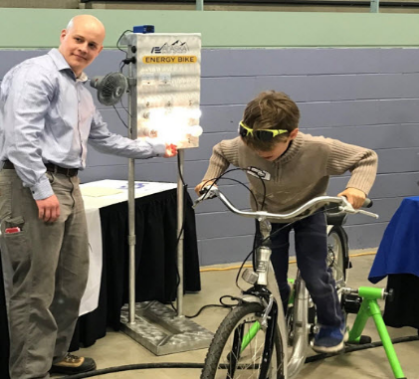
Energy Bike
The energy bike is a tool that AEA uses to help visually demonstrate the importance of energy efficiency and conservation. A bike is connected to a stationary generator that, when ridden, powers a panel of various light bulbs and electronics. Typically the panel has LED, CFL, and incandescent bulbs that can all be easily switched on or off. AEA has a small fan and hair dryer than can be plugged in as well, there is even an option for plugging in cell phone chargers or any type of electronic that plugs into a wall outlet. Riders are always surprised how much more effort it takes to power the incandescent bulb in comparison to powering multiple LED bulbs. The energy bike is a great tool for children and adults alike! Our system is compatible with many different size bikes as long as the wheel is a minimum of 16 inches. AEA attends meetings, camps, and various outreach events with the energy bike and the bike is also available for check out, free of charge, it just needs to be picked up from the AEA office on Northern Lights in Anchorage. The generator and panel can also be shipped all across the state, and funding may be available to help with those costs. Please contact us if you would like to know more or would like to reserve the bike for your event/classroom.
2010-2012 End Use Study
The Alaska Energy End-Use Study provides baseline data on energy use in residential and nonresidential buildings. Information is presented by “end-use” (e.g., heating, cooling, lighting, etc.), stratified by building type, location and other parameters. AEA funding for this project was supplemented with a grant from the US Department of Energy, as well as contributions from Chugach Electric Association and Alaska Housing Finance Corporation.
We hope this information is of use to utilities, energy planners, efficiency implementers, policy makers, and to other users of this information. The appendices include a mountain of both raw and processed data for use by energy planners and others. Your feedback on the report is most welcome.
2008 Building Energy Monitor Pilot Project
In June 2008, the Alaska Energy Authority (AEA) and other partners published a report which created a roadmap for developing energy efficiency and conservation programs and policies in Alaska (report is available here).
One of the 23 recommendations was for the State to fund a pilot program to test the effectiveness of “smart meters,” what we are now more specifically referring to as “building energy monitors” (BEM). A building energy monitor is an electronic device that displays and/or records the current whole-building electrical energy usage for the consumer, and may also display cost information and recent historical energy usage data.
The Alaska Energy Authority, through its energy efficiency and conservation program, has implemented a smaller-scale pilot test of these devices for their ability to help residential and commercial/institutional customers conserve energy and better understand how their buildings consume energy.
In October 2009, AEA solicited bids from local utilities to run a pilot project to test the effectiveness of building energy monitors in cutting electricity consumption. The bid was awarded to Chugach Electric Association in November 2009. Chugach Electric completed the project on time at the end of October, 2010. The full report is available below.
Documents and Publications
The following is a small sample of energy efficiency publications available through the Alaska Energy Authority. Additional resources may be available from our partners at Alaska Center for Energy and Power, Alaska Housing Finance Corporation, Cold Climate Housing Research Center, and others.